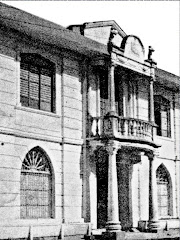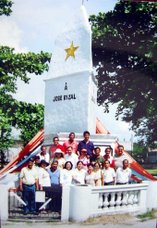Camarines Norte Historical First's
From the website http://www.camarinesnortetourism/net
The people of Camarines Norte take singular pride in the fact that the very first Rizal Monument was erected in Daet in 1898. Rightfully so, because not only is it a monument to honor our national hero. It is also a testament to the nationalist and patriotic sentiments of our own forefathers who lived during those turbulent years of the Philippine Revolution.
There are actually many other firsts in the history of Camarines Norte. They show that the province was not a mere bystander to the great events that shaped the Filipino nation, but an active participants and contributor to them.
The following historical facts are reasons for the people of Camarines Norte to take greater pride in their province and in themselves:
1. The First Resistance to the Spanish Conquest of the Bicol Peninsula was by the native inhabitants of Paracale and Mambulao (now Jose Panganiban town). They refused to submit to the first expedition led by Conquistador Juan de Salcedo in 1571, and fought against the subsequent expedition sent by Governor-General Francisco de Sande in 1576.
2. The First Bikolano Priest was Bachiller Don Gregorio Cabalquinto from Paracale, Camarines Norte. He was ordained in 1706 and spent 47 years of his life in the priesthood.
3. One of the First Organizers and members of the La Solidaridad was t5he great patriot Jose Maria Panganiban who was born in Mambulao, Camarines Norte, in February 1863. He was not only genius of a writer, but was also a very eloquent orator and much admired by his peers in the Propaganda Movement.
4. The First mason Lodge in Bicol was co-founded in 1894 by Juan Miguel, a native of Camarines Norte, who became its first Worshipful Master. Masonry played a major role in the growth of nationalism among the Bikolanos. In 1897, Juan Miguel and six other prominent men of Camarines Norte, namely, Adriano Pajarillo, Pablo del Villar, Ramon Cabezudo, Gregorio Luyon, Diego Liñan and Florentino Peñalosa, were arrested and imprisoned by the Spaniards for their for their nationalist activities.
5. The First Katipunan Organized in Bicol was in Camarines Norte. It had its beginning as early as 1894 and was formally organized in November 1987 by Ildefonso Moreno, a prominent resident of Daet.
6. The First armed uprising against the Spaniards in the Bicol Region occurred in Daet and spread to other towns of Camarines Norte. The Daet Revolt was waged by the local Katipuneros from April 13-18, 1898. Although it was short-lived, the uprising signaled the beginning of the end of Spanish colonial rule in the Bicol Region.
7. The First Revolutionary General in Charge of the military operations against the Spaniards in Southern Tagalog, Bicol and the Visayas was General Vicente Lukban who was born in Labo, Camarines Norte, in February 1860. During the Filipino-American war, he was responsible for the Balangiga Massacre in Samar where a company of American occupation forces was almost wiped out by Filipino fighters.
8. The First Elected Mayor in Manila was Dr. Justo Lukban, another native of Labo, Camarines Norte. Earlier in 1898, he was appointed by Emilio Aguinaldo as a member of the Malolos Assembly to represent Ambos Camarines, particularly Camarines Norte. His son, Jose Lukban, became the First Director of the National Bureau of Investigation (NBI).
9. The First Filipino Governor of Ambos Camarines during the American regime was Don Pimentel of Daet, Camarines Norte.
10. The First TRAMWAY (TRANVIA) in Bicol, if not in the entire Philippines, was built in Camarines Norte in 1903. It ran from the Poblacion of Daet to the port of Barra, now the town of Mercedes.
11. The First Bus Company Operating in Bicol was the A.M. Allen Transportation Company or ALATCO which started and was based in Daet, Camarines Norte.
12. The First Province with Regular Plane Service was Camarines Norte. In 1930, the Philippine Aerial Taxi Company or PATCO started its regular flights from Manila to Paracale. The First PAL FLIGHT was also from Manila to Bagasbas in Daet, Camarines Norte.
13. The First Water System in Bicol was constructed in Camarines Norte long before the outbreak of World War II.
14. The First Guerilla Unit to be organized in World War II was the Vinzons Guerilla. It was headed by Governor Wenceslao Q. Vinzons whose second-in-command was the rugged and fearless fighter Francisco “Turko” Boayes.
15. The First Encounter between the Japanese forces and a resistance group during the World War II took place in sitio Laniton in Basud, Camarines Norte, where the men of Governor Vinzons ambushed the advance troops of the Japanese occupational forces in Bicol.
16. The First Major Success of the resistance movement during the World War II was accomplished by the Vinzons Guerilla. In April-May, 1942, without any external assistance, they retook Daet and six other towns of Camarines Norte from the Japanese forces. No other guerilla unit accomplished a similar feat, particularly at that early stage of the Japanese occupation of the Philippines.
17. The First National Artist of the Philippines is the great painter Fernando Amorsolo. He was born in 1892 and grew up in Daet, Camarines Norte, whose rustic beauty and sceneries inspired him in his early paintings.
18. The First Filipino Film Producer and Director to gain International Recognition was Manuel (Urbano) Conde of Camarines Norte. His film Genghis Khan won an award in the Cannes Festival in the 1950’s. There must be surely other events giving the province of Camarines Norte such historical distinction. Indeed, most recently, the First Lady Commissioner ever appointed to head the very important Bureau of Internal Revenue is a daughter of Daet, Liwayway Vinzons Chato.


No comments:
Post a Comment